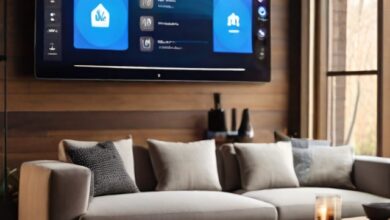How to set up a multi-room wireless audio system on a budget

Introduction
In the realm of home audio, the allure of a multi-room wireless audio system is undeniable. Imagine the luxury of moving from room to room, your favorite music following you seamlessly, enveloping your home in a blanket of sound. This dream, often perceived as a privilege reserved for those with hefty budgets, is actually more accessible than you might think. In this guide, we’ll debunk the myth that multi-room audio systems are invariably expensive, and show you how to create your own on a budget.
The beauty of a wireless audio system is not just in the convenience it offers but also in its flexibility and scalability. Whether you’re looking to add background music to your living spaces, create an immersive audio experience for movie nights, or set up zone-specific playlists for different moods and occasions, a multi-room setup can cater to all these needs. And the best part? It doesn’t have to break the bank.
Gone are the days when multi-room audio setups required complex wiring, professional installation, and a slew of expensive components. Advances in wireless technology and the proliferation of streaming services have made it easier and more affordable than ever to set up your own system. From utilizing existing devices to choosing budget-friendly new components, there are numerous ways to achieve your audio dreams without stretching your finances.
In this article, we’ll guide you through everything you need to know to set up a multi-room wireless audio system on a budget. We’ll cover the basics of how these systems work, offer advice on planning your setup, recommend budget-friendly equipment, and provide step-by-step instructions for getting everything up and running. Whether you’re a tech-savvy audiophile or a beginner, this guide will help you navigate the process with ease and confidence.
Section 1: Understanding the Basics of a Multi-Room Wireless Audio System
To embark on the journey of setting up a multi-room wireless audio system, it’s essential first to understand what it entails. A multi-room audio system is a setup that allows you to play music in multiple rooms of your home, either the same track in all rooms or different tracks in each room, all controlled from a central point like your smartphone or a dedicated controller.
Key Components: The basic components of a multi-room audio system include wireless speakers, a reliable Wi-Fi network, and a source device (like a smartphone, tablet, or computer) from which to stream music. These components work in tandem to deliver a synchronized and seamless audio experience throughout your home.
How It Works: The magic of a multi-room system lies in its wireless capabilities. Unlike traditional wired audio systems that require extensive cabling, wireless systems use your home Wi-Fi network to stream music. This means you can place speakers in different rooms without worrying about running cables through walls or floors. Each speaker connects to your network, allowing you to control what plays in each room through an app or a dedicated remote.
The flexibility of a wireless system is one of its biggest advantages. You can start with a single speaker and gradually add more as your needs and budget grow. This scalability ensures that your audio system can evolve with your lifestyle, making it a long-term investment in your home entertainment setup.
Compatibility and Integration: When planning your system, it’s important to consider the compatibility of different devices. Many wireless speakers now come with built-in support for popular streaming services like Spotify, Apple Music, and Pandora. Some also offer compatibility with smart home systems, allowing for voice control through devices like Amazon Alexa or Google Assistant.
Additionally, if you already have some audio equipment, you might be able to integrate it into your new system. Certain wireless audio adapters can turn traditional speakers into wireless ones, seamlessly integrating them into your multi-room setup.
By understanding these basics, you’re well-equipped to start planning your multi-room wireless audio system. Remember, the goal is to create a system that not only sounds great but also fits your budget and lifestyle.
Section 2: Planning Your Multi-Room Audio System
Before diving into the purchase of equipment, it’s crucial to plan your multi-room audio system thoughtfully. This planning phase is about understanding your needs, assessing your space, and ensuring your future setup will deliver the desired audio experience.
Determining Your Needs: First, consider how many rooms you want to include in your system and what kind of audio experience you’re looking for in each. Do you want background music in your kitchen and dining area? Or are you aiming for a more immersive sound in your living room for movie nights? Understanding these needs will guide your decisions on the type and number of speakers required.
Assessing Your Home Layout: The layout of your home will significantly influence speaker placement. Ideally, speakers should be placed for optimal sound coverage without being obstructive. Consider the acoustics of each room – factors like room size, furniture, and flooring can affect sound quality. In larger rooms, you might need more than one speaker to fill the space with sound adequately.
Device Compatibility: If you already own some audio devices, check their compatibility with multi-room audio technology. Some older devices can be integrated into a new system with the right adapters or connectors. This not only saves money but also allows you to use equipment you’re already familiar with.
Section 3: Choosing Budget-Friendly Equipment
With a plan in hand, the next step is selecting the right equipment for your budget-friendly multi-room audio system. The market is filled with options ranging from high-end models to more affordable ones that still offer great sound quality.
Affordable Wireless Speakers: Look for speakers that offer the best balance between cost and quality. Brands like Sonos, Bose, and Yamaha offer high-quality speakers that might be on the pricier side, but there are also more affordable options from companies like Anker and JBL. Keep an eye out for sales or refurbished models, which can be great deals.
Quality Second-Hand Equipment: Don’t overlook the second-hand market. Websites like eBay, Craigslist, and local Facebook selling groups can be goldmines for finding gently used audio equipment at a fraction of the original price. Just be sure to test the equipment before finalizing any purchase.
Balancing Cost and Quality: While budget is a key consideration, it’s important to remember that the cheapest option isn’t always the best value. Investing a bit more in a reliable and high-quality speaker can save you money in the long run, as these are less likely to need early replacement.
Section 4: The Setup Process
Now that you have your equipment, it’s time to set up your multi-room wireless audio system. This process can vary depending on the devices you’ve chosen, but here’s a general guide to get you started.
Step-by-Step Setup:
- Place Your Speakers: Based on your earlier planning, position your speakers in their designated rooms. Ensure they’re placed for optimal sound and within range of your Wi-Fi network.
- Connect to Wi-Fi: Power on your speakers and connect them to your home Wi-Fi network. This usually involves using a companion app provided by the speaker manufacturer.
- Syncing Devices: If you’re using speakers from the same brand, they should easily sync with each other. If not, you may need a central hub or additional software to manage different devices.
- Testing and Troubleshooting: Play audio through each speaker to ensure they’re working correctly. Check for any sync issues or audio delays and consult the manufacturer’s support resources if needed.
Optimizing Audio Quality: Spend some time tweaking the settings for each speaker. Many apps allow you to adjust bass, treble, and other audio settings. Experiment with these to find the best sound for each room.
Common Issues and Solutions:
- Wi-Fi Connectivity: Ensure your home Wi-Fi has strong coverage in all areas where speakers are placed. Consider a Wi-Fi extender if there are connectivity issues.
- Audio Sync: If there’s a delay between rooms, check if your system has a setting to adjust the sync.
- Software Updates: Regularly update your speakers’ firmware and apps to ensure optimal performance and new features.
Section 5: Software and Streaming Services
To maximize the potential of your multi-room audio system, integrating it with the right software and streaming services is key. This will allow you to control your music seamlessly and enjoy a wide range of audio content.
Streaming Services: Most wireless speakers today support popular streaming services like Spotify, Apple Music, and Amazon Music. Choose a service that offers the best library for your tastes, and consider a family plan if multiple people will be using the system.
Control Apps: Use the control app associated with your speaker brand to manage your multi-room setup. These apps let you choose which speaker plays which audio stream and adjust volume and other settings individually or group-wise.
Customizing Playlists: Personalize your audio experience by creating playlists for different occasions or moods. Most streaming services offer playlist creation and recommendation features to enhance your listening experience.
Section 6: Maintenance and Upgrades
Maintaining your multi-room audio system ensures its longevity and performance. As technology evolves, you may also find opportunities to upgrade your system.
Routine Maintenance: Regularly dust your speakers and check connections to keep everything in working order. Ensure software and firmware are up to date for the latest features and security.
When to Upgrade: Consider upgrading when new models offer significantly better features or when your current setup no longer meets your needs. Plan upgrades during sales seasons to get the best deals.
Staying Informed: Keep an eye on the latest trends and technologies in wireless audio. Online forums, tech blogs, and product reviews are great resources for staying informed and getting tips from other audio enthusiasts.
Conclusion
Setting up a multi-room wireless audio system on a budget is an achievable goal. With thoughtful planning, careful selection of equipment, and proper setup and maintenance, you can enjoy a high-quality audio experience throughout your home. Remember, the key is to start small and expand your system as your needs and budget allow. Enjoy the journey of building and fine-tuning your personalized audio oasis!
Frequently asked questions (FAQs)
Q1. What is a multi-room wireless audio system?
A1: A multi-room wireless audio system allows you to play music in different rooms of your home using a network of interconnected wireless speakers. You can play the same music in all rooms or different tracks in each room, controlled from a central device like a smartphone or tablet.
Q2. Do I need a strong Wi-Fi network for a multi-room audio system?
A2: Yes, a reliable and strong Wi-Fi network is crucial for the seamless operation of a multi-room audio system. If your Wi-Fi signal is weak in certain areas of your home, you might consider a Wi-Fi extender or mesh network system to ensure consistent coverage.
Q3. Can I integrate existing speakers into a new wireless system?
It depends on the speakers. Some traditional speakers can be integrated into a wireless system using adapters or by connecting them to a compatible receiver or amplifier that supports wireless streaming.
Q4. Are there affordable brands for wireless speakers suitable for a multi-room setup?
A4: Yes, there are several affordable brands that offer quality wireless speakers suitable for multi-room setups, including Anker, JBL, and Sony. Look for models that suit your budget and check for features like compatibility with streaming services and ease of integration with other speakers.
Q5. How can I control my multi-room audio system?
A5: Most multi-room audio systems are controlled via a smartphone or tablet app provided by the speaker manufacturer. These apps allow you to select which speakers to play, adjust volume, create groups of speakers, and sometimes even adjust sound settings.



